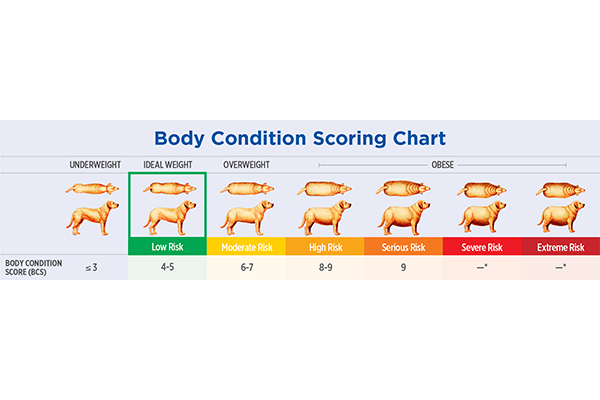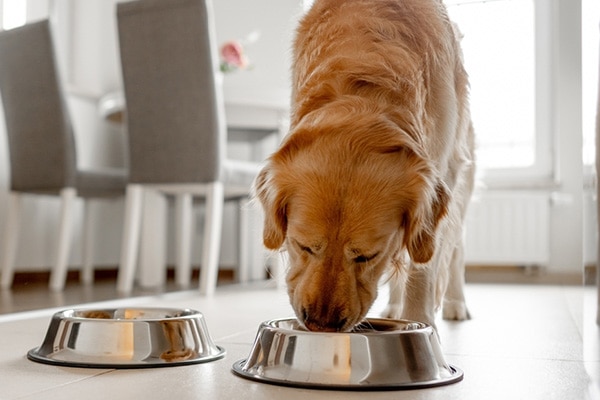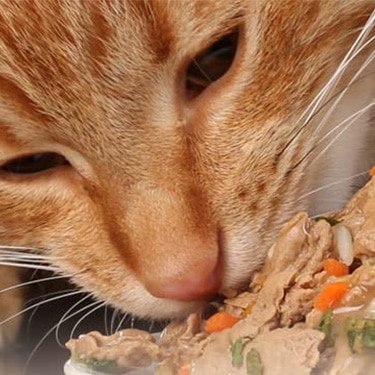

One of the most visible signs of a dog's health is their body condition. In general, lean, well-muscled dogs are best suited to enjoy long, high-quality lives due to reduced risk of chronic disease and painful conditions like osteoarthritis. But how thin is too thin, and when should you consider feeding your pup dog food for weight gain? Read on to learn more about healthy weight gain for dogs.
How to Know if You Have a Skinny Dog
Judging whether your dog is underweight can be challenging, especially if your furry friend is very furry. Different dog breeds also have different body shapes — a barrel-chested French or English bulldog may look overweight compared to a deep-chested racing greyhound, even if they're not.
The Importance of Veterinary Expertise
Thankfully, your veterinarian can help you determine your dog's body condition for an accurate assessment. They may use a couple of tools to do so.
Body Condition Score
Vets often use body condition scoring (BCS) systems to assess pets' body weight and condition. Using these systems, they observe certain features from a bird's-eye or side view, including the waist, ribs and abdomen tuck. BCS grades a dog's or cat's body condition according to a numerical score. On a scale of one to nine — emaciated to obese — the ideal score is typically a four or five. On a scale of one to five, the ideal score is three.
The Hand Test
Your vet may also use their hand as a reference to help determine your dog's body condition. To start, they'll gently place their hand on your dog's ribs. If their ribs feel like the back of a hand, covered with a light layer of fat but still palpable, your dog's weight is probably just right. If their ribs feel like knuckles, they're likely too thin. (And if their ribs feel like a palm, they may be too heavy.)

Why Is My Dog So Skinny?
OK, so now you're wondering: But why is my dog so thin? A skinny dog typically isn't eating enough or is burning more calories than they eat. This can occur in highly active dogs or dogs with diseases that consume calories, like intestinal parasites or certain cancers.
Appetite Loss or Insufficient Food
Dogs can lose their appetites for many reasons, including stress, dental disease, nausea or depression. This can be fairly obvious, such as if they suddenly stop eating. However, loss of appetite can also happen gradually over time, making it harder to notice.
Another reason your dog might be too thin is lack of access to sufficient food. If you have multiple dogs, keep an eye on any food-bowl bullies and make sure they're all getting their daily recommended amount of food.
Diseases Associated With Weight Loss
Sometimes, weight loss is the only sign of disease. Health conditions that can cause weight loss in dogs include:
Age-related gastrointestinal (GI) decline in senior dogs
GI disorders (e.g., inflammatory bowel disease, malabsorption disorders, esophageal reflux)
Cognitive dysfunction
Kidney or liver disease
Pain

How to Help a Dog Gain Weight
While a skinny dog isn't typically a medical emergency, schedule a checkup with your veterinarian to determine the cause of weight loss. Your vet will start by ruling out and addressing any underlying medical conditions. If they don't find any issues, they can recommend strategies to help get your dog back on track.
There are a few things to consider when it comes to how to help a dog gain weight safely, so your vet's partnership is key. Here are some methods they may suggest to help put weight on a dog and get them to their ideal body condition.
Increase Their Daily Amount of Food
Underweight dogs may need more meals per day or free access to dry food to gain weight. However, free-choice feeding can lead to obesity and be difficult to control in multi-pet households, so it's only recommended in certain circumstances. Check with your vet to see whether your dog is a good candidate for free feeding, and confirm their daily recommended feeding amount.
Provide a Dedicated Meal Space
If your dog is nervous, place their food bowl in a low-traffic, quiet area away from children and other pets. Avoid putting food bowls near loud or active objects, such as a cycling furnace, air conditioner, washer or dryer.
Simplify Their Meals
If you tend to dress up your dog's food with toppers or fuss over your dog during mealtime, try offering simple meals without garnishes.
Jazz Up Their Meals
On the other hand, some dogs can be enticed to eat with a little more attention to mealtime. Try heating your dog's food in the microwave for a few seconds to enhance its aroma. Use an appropriate microwavable container, and check the temperature before feeding.
Your vet may also recommend adding a small amount of shredded skinless rotisserie chicken to their food. Your dog's daily meal should be at least 90% complete and balanced dog food, so follow their instructions closely.

Switch to a New Food
If your dog has a picky appetite, consider trying different flavors and consistencies (both dry and wet). Check with your veterinarian before changing your dog's food, and gradually transition to a new food to avoid digestive upset.
Dog Food for Weight Gain
Thin, highly active adult dogs may need more calories. This is why some of the best dog foods for dogs to gain weight are high-calorie performance foods. Performance foods are energy-dense, delivering more calories per mouthful while still providing a balanced amount of essential nutrients.
Dogs who've undergone surgery or a debilitating illness often benefit from a recovery formula while they recuperate. Easily digested and calorie-dense, recovery formulas are available by prescription through your vet. Older dogs struggling to keep on weight may benefit from a highly digestible senior food rich in antioxidants, omega-3 and -6 fatty acids, probiotics and prebiotics.
Getting Your Skinny Dog the Support They Need
If you think your dog is underweight, consult your veterinarian. They can tell you the ideal weight for your dog, provide advice on how to maintain or achieve that weight and determine whether any underlying issues are contributing to weight loss. Otherwise, keep giving your dog the love and care you always do.




















